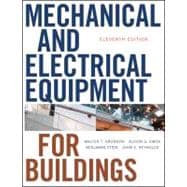
Note: Supplemental materials are not guaranteed with Rental or Used book purchases.
Purchase Benefits
What is included with this book?
Alison G. Kwok, PhD, AIA, LEED AP, is Professor of Architecture at the University of Oregon, Eugene, teaches design studios, seminars in building performance, as well as courses in environmental technology. Kwok has served as a board member for the Arch-itectural Research Centers Consortium and is a past president of the Society of Building Science Educators, a member of several ASHRAE committees, and a member of the USGBC's Formal Education Committee.
Benjamin Stein is a consulting engineer with more than fifty years of experience in all phases of environmental control system design. He currently resides in Jerusalem, Israel.
John S. Reynolds, AIA, is Professor Emeri-tus of Architecture at the University of Oregon, Eugene, and is a registered architect in private practice.
Acknowledgments.
PART I DESIGN CONTEXT.
Chapter 1 Design Process.
Chapter 2 Environmental Resources.
Chapter 3 Sites and Resources.
Chapter 4 Comfort and Design Strategies.
Chapter 5 Indoor Air Quality.
PART II THERMAL CONTROL.
Chapter 6 Solar Geometry and Shading Devices.
Chapter 7 Heat Flow.
Chapter 8 Designing For Heating and Cooling.
Chapter 9 HVAC for Smaller Buildings.
Chapter 10 Large Building HVAC Systems.
PART III ILLUMINATION.
Chapter 11 Lighting Fundamentals.
Chapter 12 Light Sources.
Chapter 13 Lighting Design Process.
Chapter 14 Daylighting Design.
Chapter 15 Electric Lighting Design.
Chapter 16 Electric Lighting Applications.
PART IV ACOUSTICS.
Chapter 17 Fundamentals of Architectural Acoustics.
Chapter 18 Sound in Enclosed Spaces.
Chapter 19 Building Noise Control.
PART V WATER AND WASTE.
Chapter 20 Water and Basic Design.
Chapter 21 Water Supply.
Chapter 22 Liquid Waste.
Chapter 23 Solid Waste.
PART VI FIRE PROTECTION.
Chapter 24 Fire Protection.
PART VII ELECTRICITY.
Chapter 25 Principles of Electricity.
Chapter 26 Electrical Systems and Materials. Service and Utilization.
Chapter 27 Electrical Systems and Materials. Wiring and Raceways.
Chapter 28 Electric Wiring Design.
Chapter 29 Photovoltaic Systems.
PART VIII SIGNAL SYSTEMS.
Chapter 30 Signal Systems.
PART IX TRANSPORTATION.
Chapter 31 Vertical Transportation: Passenger Elevators.
Chapter 32 Vertical Transportation. Special Topics.
Chapter 33 Moving Stairways and Walks.
PART X APPENDICES.
Appendix A Metrication, SI Units, and Conversions.
Appendix B Climatic Conditions for the United States, Canada, and Mexico.
Appendix C Solar and Daylighting Design Data.
Appendix D Solar Geometry.
Appendix E Thermal Properties of Materials and Assemblies.
Appendix F Heating and Cooling Design Guidelines and Information.
Appendix G Standards/Guidelines for Energy- and Resource-Efficient Building Design.
Appendix H Annual Solar Performance.
Appendix I Economic Analysis.
Appendix J Lamp Data.
Appendix K Sound Transmission Data for Walls.
Appendix L Sound Transmission and Impact Insulation Data for Floor/Ceiling Constructions.
Appendix M Design Analysis Software.
Index.
The New copy of this book will include any supplemental materials advertised. Please check the title of the book to determine if it should include any access cards, study guides, lab manuals, CDs, etc.
The Used, Rental and eBook copies of this book are not guaranteed to include any supplemental materials. Typically, only the book itself is included. This is true even if the title states it includes any access cards, study guides, lab manuals, CDs, etc.